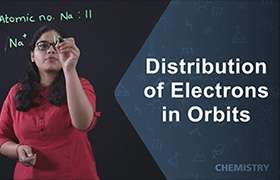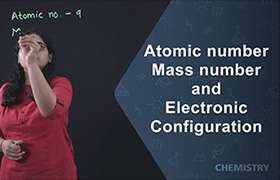CBSE Class 9 Answered
In K, L,M, N shells,in the N shell it can accommodate 32 electrons. So why the outermost shell can accommodate only 8 shells?
Asked by Saloniagrawal | 26 Jan, 2011, 09:11: PM
Dear Student
The shells are divided into subshells also.
An atom's electron shells are filled according to the following theoretical constraints:
- Each s subshell holds at most 2 electrons
- Each p subshell holds at most 6 electrons
- Each d subshell holds at most 10 electrons
- Each f subshell holds at most 14 electrons
- Each g subshell holds at most 18 electron
In K we have only 1 subshell that is s, so maximum number of electrons in K shell is 2
In L we have 2 subshell that is s and p, so maximum number of electrons in L shell is 2+ 6= 8
In M we have 3 subshell that is s, p and d so maximum number of electrons in M shell is 2+6+10.
In N we have s, p, d and f subshells, so maximum number of electrons in N shell is 2+6+10+14 = 32 electrons.
During filling of electrons the following rules are considered.
- Orbitals are filled in the order of increasing n+l;
- Where two orbitals have the same value of n+l, they are filled in order of increasing n.
So, we follow this order for filling the orbitals:
1s, 2s, 2p, 3s, 3p, 4s, 3d, 4p, 5s, 4d, 5p, 6s, 4f, 5d, 6p, 7s, 5f, 6d, and 7p
We hope that clarifies your query.
Regards
Team
Topperlearning
Answered by | 27 Jan, 2011, 08:59: AM
Application Videos
Concept Videos
CBSE 9 - Chemistry
Asked by shivalaxmi0205 | 08 Mar, 2023, 07:47: PM
CBSE 9 - Chemistry
Asked by rekhachaturvedu422 | 01 Aug, 2022, 04:16: PM
CBSE 9 - Chemistry
Asked by pandeyabhishek1576 | 16 Feb, 2022, 01:24: PM
CBSE 9 - Chemistry
Asked by senniasamy | 10 Jan, 2022, 08:48: PM
CBSE 9 - Chemistry
Asked by nathdarshana | 20 Nov, 2020, 07:03: PM
CBSE 9 - Chemistry
Asked by archanakad | 25 Aug, 2020, 08:59: PM
CBSE 9 - Chemistry
Asked by namyairmalwar9803.5sdatl | 07 Jun, 2020, 01:47: PM
CBSE 9 - Chemistry
Asked by fathima1012006 | 31 May, 2020, 10:44: AM
CBSE 9 - Chemistry
Asked by gspublicschool | 27 Apr, 2020, 11:23: AM
CBSE 9 - Chemistry
Asked by Jaiwanthsiva | 15 Apr, 2020, 01:51: PM











